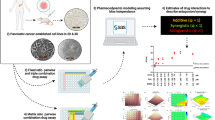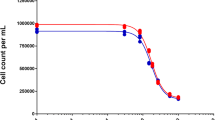Abstract
Purpose
The use of in vitro drug cytotoxicity assays for the assessment of drug–drug interactions that lead to synergy may not take into account the many cellular determinants responsible for combination effects. Administration of the anticancer drug CPT-11, for example, is associated with rapid conversion of drug from its active lactone form to the inactive carboxylate form. Thus it is difficult to model, in vitro, the behavior of this drug when used as a single agent and when used in a combination setting, this factor may contribute to the interactions measured. Therefore, the objective of this study was to examine the influence of CPT-11 lactone ratio on the cellular accumulation of CPT-11 when used as a single agent and under conditions where it is used in combination with cisplatin.
Methods
A fixed ratio experimental design was used and drug ratios of CPT-11 and cisplatin were judged to be antagonistic, additive, or synergistic to the non-small cell lung cancer cell line, H460, on the basis of the median effect analysis methodology of Chou and Talalay. The influence of extracellular pH on CPT-11 accumulation was evaluated at pH 7.4 and pH 6.6 when the drug was added immediately to the cells or first pre-equilibrated at the indicated pH. These studies were completed in the presence and absence of cisplatin.
Results
When CPT-11 was added as a single agent to cells in pH = 7.4 media, the drug underwent hydrolysis to the carboxylate form; however, there was a rapid accumulation of the CPT-11 lactone form which peaked at 3,800 pmol/mg protein by 30 min and drops to 570 pmol/mg protein by 24 h. In pH = 6.6 media, accumulation of CPT-11 lactone was substantially lower over a 60 min timecourse; however, the cellular uptake measured at 24 h was comparable to that observed when the drug was added into pH 7.4 media. When evaluating CPT-11 lactone accumulation in a combination setting with cisplatin no significant difference in either CPT-11 lactone accumulation or cisplatin accumulation was observed, suggesting that drug interactions that led to synergy were mechanistically based. Results are presented which suggest that when cisplatin and CPT-11 are used in combination, there was a significant prolongation of platinum association with DNA compared to results obtained when cisplatin was used alone.
Conclusion
These results suggest that the CPT-11 lactone to carboxylate ratio does not influence the accumulation of the active CPT-11 lactone form in H460 cells and that CPT-11 does not influence cisplatin uptake when used in combination. It is argued, therefore, that the improved cytotoxicity between CPT-11 and cisplatin, as determined using cell-based assay, has the potential to be preserved in vivo assuming the optimal drug–drug ratio and concentration can be effectively delivered to the tumor.





Similar content being viewed by others
References
Adams DJ, Wahl ML, Flowers JL, Sen B, Colvin M, Dewhirst MW, Manikumar G, Wani MC (2006) Camptothecin analogs with enhanced activity against human breast cancer cells. II. Impact of the tumor pH gradient. Cancer Chemother Pharmacol 57:145–154
Akimoto K, Kawai A, Ohya K (1994) Kinetic studies of the hydrolysis and lactonization of camptothecin and its derivatives, CPT-11 and SN-38, in aqueous solution. Chem Pharm Bull 42:2135–2138
Atsumi R, Okazaki O, Hakusui H (1995) Metabolism of Irinotecan to SN-38 in a tissue-isolated tumor model. Biol Pharm Bull 18:1024–1026
Boyd G, Smyth JF, Jodrell DI, Cummings J (2001) High-performance liquid chromatographic technique for the simultaneous determination of lactone and hydroxy acid forms of camptothecin and SN-38 in tissue culture media and cancer cells. Anal Biochem 297:15–24
Burke TG, Munshi CB, Mi Z, Jiang Y (1995) The important role of albumin in determining the relative human blood stabilities of the camptothecin anticancer drugs. J Pharm Sci 84:518–519
Chauvier D, Chourpa I, Maizieres M, Riou J-F, Dauchez M, Alix AJP, Manfait M (2003) E-ring conformation has a key role in cleavable complex formation: homocamptothecin versus camptothecins. J Mol Struct 651–653:55–65
Chou TC, Talalay P (1984) Quantitative analysis of dose-effect relationships: the combined effects of multiple drugs or enzyme inhibitors. Adv Enzyme Regul 22:27–55
Gabr A, Kuin A, Aalders M, El-Gawly H, Smets LA (1997) Cellular pharmacokinetics and cytotoxicity of camptothecin and topotecan at normal and acidic pH. Cancer Res 57:4811–4816
Gerweck LE, Seetharaman K (1996) Cellular pH gradient in tumor versus normal tissue: potential exploitation for the treatment of cancer. Cancer Res 56:1194–1198
Giovanella BC, Harris N, Mendoza J, Cao Z, Liehr J, Stehlin JS (2000) Dependence of anticancer activity of camptothecins on maintaining their lactone function. Ann N Y Acad Sci 922:27–35
Go RS, Adjei AA (1999) Review of the comparative pharmacology and clinical activity of cisplatin and carboplatin. J Clin Oncol 17:409–422
Goldwasser F , Valenti M, Torres R, Kohn KW, Pommier Y (1996) Potentiation of cisplatin cytotoxicity by 9-aminocamptothecin. Clin Cancer Res 2:687–693
Guemei AA, Cottrell J, Band R, Hehman H, Prudhomme M, Pavlov MV, Grem JL, Ismail AS, Bowen D, Taylor RE, Takimoto CH (2001) Human plasma carboxylesterase and butyrylcholinesterase enzyme activity: correlations with SN-38 pharmacokinetics during a prolonged infusion of irinotecan. Cancer Chemother Pharmacol 47:283–290
Ikegami T, Ha L, Arimori K, Latham P, Kobayashi K, Ceryak S, Matsuzaki Y, Bouscarel B (2002) Intestinal alkalization as a possible preventive mechanism in irinotecan (CPT-11)-induced diarrhea. Cancer Res 62:179–187
Kakolyris S, Kouroussis C, Souglakos J, Agelaki S, Kalbakis K, Vardakis N, Vamvakas L, Georgoulias V (2001) Cisplatin and irinotecan (CPT-11) as second-line treatment in patients with advanced non-small cell lung cancer. Lung Cancer 34(Suppl 4):S71–S76
Kano Y, Suzuki K, Akutsu M, Suda K, Inoue Y, Yoshida M, Sakamoto S, Miura Y (1992) Effects of CPT-11 in combination with other anti-cancer agents in culture. Int J Cancer 50:604–610
Kanzawa F, Koizumi F, Koh Y, Nakamura T, Tatsumi Y, Fukumoto H, Saijo N, Yoshioka T, Nishio K (2001) In vitro synergistic interactions between the cisplatin analog nedaplatin and the DNA topoisomerase I inhibitor irinotecan and the mechanism of this interaction. Clin Cancer Res 7:202–209
Kawato Y, Aonuma M, Hirota Y, Kuga H, Sato K (1991) Intracellular roles of SN-38, a metabolite of the camptothecin derivative CPT-11, in the antitumor effect of CPT-11. Cancer Res 51:4187–4191
Kobayashi K, Bouscarel B, Matsuzaki Y, Ceryak S, Kudoh S, Fromm H (1999) pH-dependent uptake of irinotecan and its active metabolite, SN-38, by intestinal cells. Int J Cancer 83:491–496
Kohn KW, Pommier Y (2000) Molecular and biological determinants of the cytotoxic actions of camptothecins: perspective for the development of new topoisomerase I inhibitors. Ann N Y Acad Sci 922:11–26
Komuro Y, Udagawa Y, Susumu N, Aoki D, Kubota T, Nozawa S (2001) Paclitaxel and SN-38 overcome cisplatin resistance of ovarian cancer cell lines by down-regulating the influx and efflux system of cisplatin. Jpn J Cancer Res 92:1242–1250
Laco GS, Collins JR, Luke BT, Kroth H, Sayer JM, Jerina DM , Pommier Y (2002) Human topoisomerase I inhibition: docking camptothecin and derivatives into a structure-based active site model. Biochemistry 41:1428–1435
Laurencot CM, Kennedy KA (1995) Influence of pH on the cytotoxicity of cisplatin in EMT6 mouse mammary tumor cells. Oncol Res 7:371–379
Liu LF, Desai SD, Li T-K, Mao Y, Sun M, Sim S-P (2000) Mechanism of action of camptothecin. Ann N Y Acad Sci 922:1–10
Ma JG, Maliepaard M, Nooter K, Boersma AWM, Verweij J, Stoter G, Schellens JHM (1998) Synergistic cytotoxicity of cisplatin and topotecan or SN-38 in a panel of 8 solid-tumor cell lines in vitro. Cancer Chemother Pharmacol 41:307–316
Masuda N, Fukuoka M, Takada M, Kusunoki Y, Negoro S, Matsui K, Kudoh S, Takifuji N, Nakagawa K, Kishimoto S (1992) CPT-11 in combination with cisplatin for advanced non-small-cell lung cancer. J Clin Oncol 10:1775–1780
Masumoto N, Nakano S, Esaki T, Fujishima H, Tatsumoto T, Niho Y (1995) Inhibition of removal of cis-diamminedichloroplatinum(II)-induced DNA interstrand cross-links by 7-ethyl-10-hydroxycamptothecin in HST-1 human squamous-carcinoma cells. Int J Cancer 62:70–75
Mathijssen RHJ, Loos WJ, Verweij J, Sparreboom A (2002) Pharmacology of topoisomerase I inhibitors irinotecan (CPT-11) and topotecan. Curr Cancer Drug Targets 2:103–123
Mayer LD, Harasym TO, Tardi PG, Harasym NL, Shew CR, Johnstone SA, Ramsay EC, Bally MB, Janoff AS (2006) Ratiometric dosing of anticancer drug combinations: controlling drug ratios after systemic administration regulates therapeutic activity in tumor-bearing mice. Mol Cancer Ther 5:1854–1863
Minagawa Y, Kigawa J, Ishihara H, Itamochi H, Terakawa N (1994) Synergistic enhancement of cisplatin cytotoxicity by SN-38, an active metabolite of CPT-11, for cisplatin-resistant HeLa cells. Jpn J Cancer Res 85:966–971
Negoro S, Masuda N, Takada Y, Sugiura T, Kudoh S, Katakami N, Ariyoshi Y, Ohashi Y, Niitani H , Fukuoka M (2003) Randomised phase III trial of irinotecan combined with cisplatin for advanced non-small-cell lung cancer. Br J Cancer 88:335–341
Ohtsuka Kimihiko, Inoue Shoichi, Kameyama Masayo, Kanetoshi Akio, Fujimoto Toru, Takaoka Kazuo, Araya Yoshikazu, Shida Akira (2003) Intracellular conversion of irinotecan to its active form, SN-38, by native carboxylesterase in human non-small cell lung cancer. Lung Cancer 41:187–198
Pavillard V, Agostini C, Richard S, Charasson V, Montaudon D, Robert J (2002) Determinants of the cytotoxicity of irinotecan in two human colorectal tumor cell lines. Cancer Chemother Pharmacol 49:329–335
Ramsay EC, Dos Santos N, Dragowska WH, Laskin JJ, Bally MB (2005) The formulation of lipid-based nanotechnologies for the delivery of fixed dose anticancer drug combinations. Curr Drug Deliv 2:341–351
Sanghani SP, Quinney SK, Fredenburg TB, Sun Z, Davis WI, Murry DJ, Cummings OW, Seitz DE, Bosron WF (2003) Carboxylesterases expressed in human colon tumor tissue and their role in CPT-11 hydrolysis. Clin Cancer Res 9:4983–4991
Tsunoda T, Tanimura H, Hotta T, Tani M, Iwahashi M, Ishimoto K, Tanaka H, Matsuda K, Yamaue H (2000) In vitro augmentation of antitumor effect in combination with CPT-11 and CDDP for human colorectal cancer. J Surg Oncol 73:6–11
Van Ark-Otte J, Kedde MA, Van Der Vijgh WJF, Dingemans AMC, Jansen WJM, Pinedo HM, Boven E, Giaccone G (1998) Determinants of CPT-11 and SN-38 activities in human lung cancer cells. Br J Cancer 77:2171–2176
van Waardenburg RCAM, de Jong LA, van Eijndhoven MAJ, Verseyden C, Pluim D, Jansen LET, Bjornsti M-A, Schellens JHM (2004) Platinated DNA adducts enhance poisoning of DNA topoisomerase I by camptothecin. J Biol Chem 279:54502–54509
Vukovic V, Tannock IF (1997) Influence of low pH on cytotoxicity of paclitaxel, mitoxantrone and topotecan. Br J Cancer 75:1167–1172
Xu G, Zhang W, Ma MK, McLeod HL (2002) Human carboxylesterase 2 is commonly expressed in tumor tissue and is correlated with activation of irinotecan. Clin Cancer Res 8:2605–2611
Zeghari-Squalli N, Raymond E, Cvitkovic E, Goldwasser F (1999) Cellular pharmacology of the combination of the DNA topoisomerase I inhibitor SN-38 and the diaminocyclohexane platinum derivative oxaliplatin. Clin Cancer Res 5:1189–1196
Acknowledgements
This research was funded by a grant from the Canadian Institutes of Health Research (CIHR).
Author information
Authors and Affiliations
Corresponding author
Rights and permissions
About this article
Cite this article
Zastre, J., Anantha, M., Ramsay, E. et al. Irinotecan–cisplatin interactions assessed in cell-based screening assays: cytotoxicity, drug accumulation and DNA adduct formation in an NSCLC cell line. Cancer Chemother Pharmacol 60, 91–102 (2007). https://doi.org/10.1007/s00280-006-0353-z
Received:
Accepted:
Published:
Issue Date:
DOI: https://doi.org/10.1007/s00280-006-0353-z




